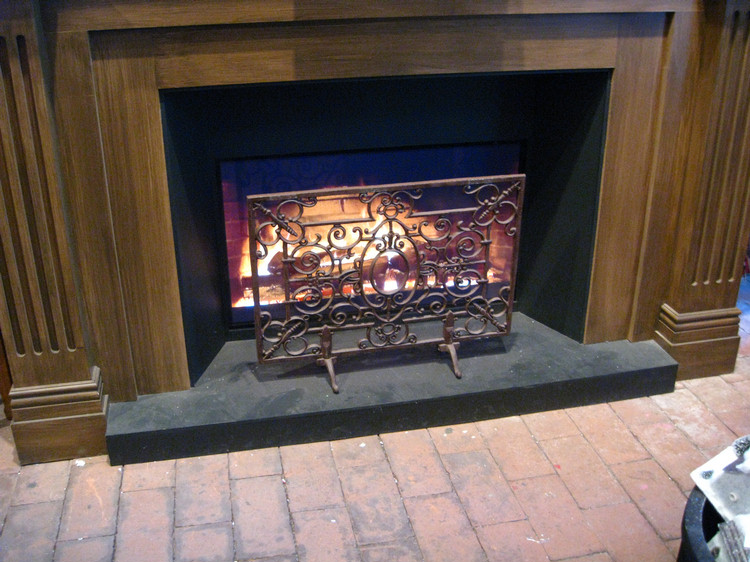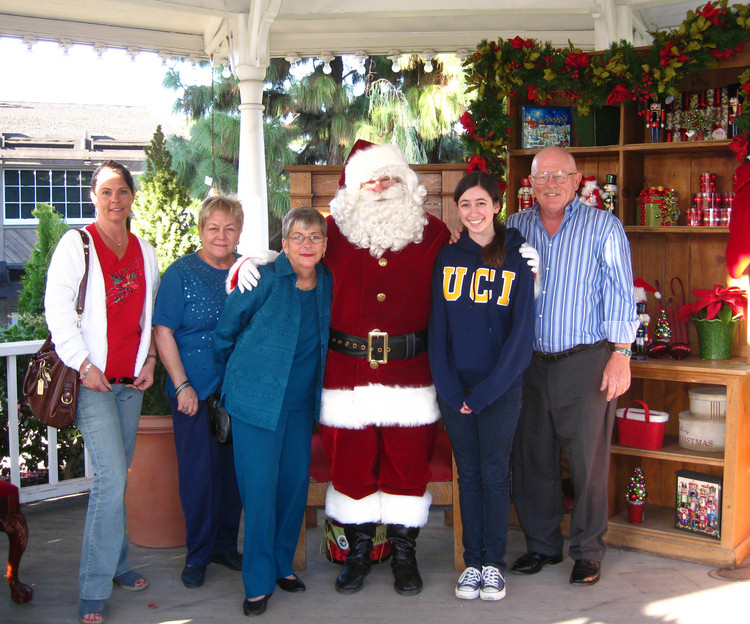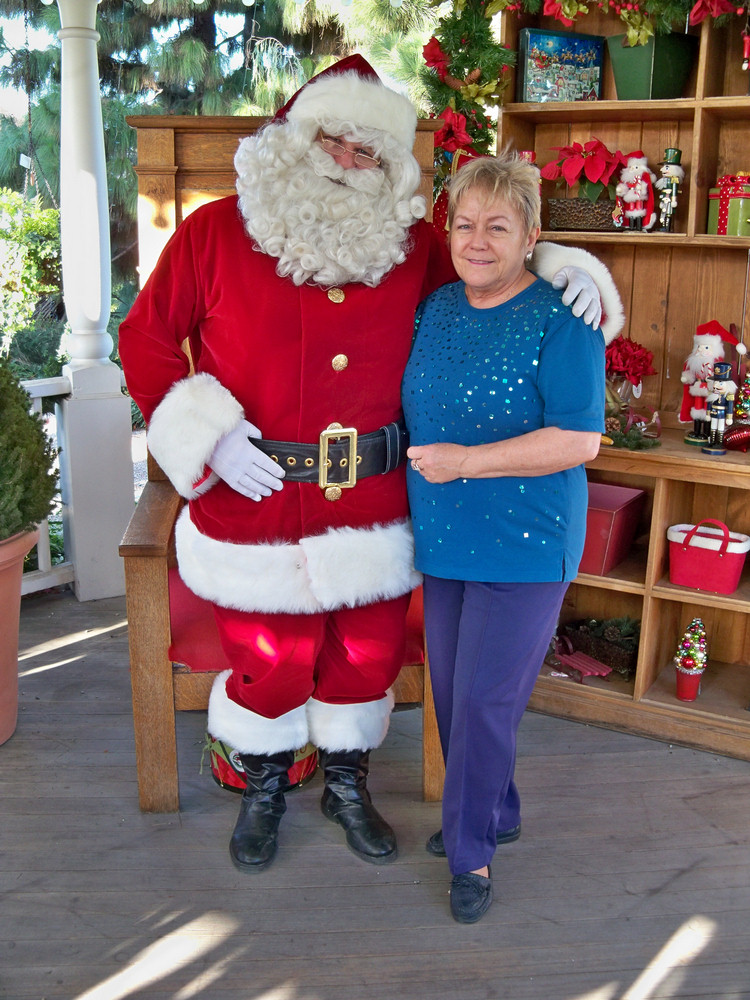11/28/2009 ... A Time For Roger's Gardens (Page Three)
While shopping we texted Hannah and found out she was flying down in a few minutes. We decided to pick her up at the air[port and take her to Roger's Gardens also! Fun with Sue, Carrie, Jeanette, and Hannah!

Roger's Gardens is a fun place to go!
Did You Know? -Sitting upon seven acres across from Fashion Island, Roger’s Gardens has grown to be known as ‘America’s Most Beautiful Home and Garden Center’.
Presented in a garden like setting, our Nursery offers one of the most extensive varieties of Plants, Outdoor Living, Home Decor, Landscape, Holiday, Pottery and Fountains.
As ‘America’s Most Beautiful Home and Garden Center’, Roger’s Gardens has taken quiet pride in being the recipient of many awards including the AmeriChristmas award and the Los Angeles Arboretum award.

The trees reach for the sky!

Great place to put a high definition television!

Check out the bird on the top of the tree


Aunt Sue and Hannah discover a treasure

Each shelf holds a treasure for someone


UCI??? What's that?


Always look up

Checkout all the gears and goodies in the overheads
Did you know? - A gear is a rotating machine part having cut teeth, or cogs, which mesh with another toothed part in order to transmit torque. Two or more gears working in tandem are called a transmission and can produce a mechanical advantage through a gear ratio and thus may be considered a simple machine. Geared devices can change the speed, magnitude, and direction of a power source. The most common situation is for a gear to mesh with another gear, however a gear can also mesh a non-rotating toothed part, called a rack, thereby producing translation instead of rotation.
The gears in a transmission are analogous to the wheels in a pulley. An advantage of gears is that the teeth of a gear prevent slipping.
When two gears of unequal number of teeth are combined a mechanical advantage is produced, with both the rotational speeds and the torques of the two gears differing in a simple relationship


Creatures everywhere

Holy mackrel!
$1,000 for a 10" tree filled with junk jewlery
Did you know? - Costume jewelry (also called fashion jewelry, junk jewelry, fake jewelry, or fallalery) is the first jewelry (jewellery) manufactured as ornamentation for the masses to complement a particular fashionable garment or "costume".
Costume jewelry came into being in the 1930s as a cheap, disposable accessory meant to be worn with a specific outfit. It was intended to be fashionable for a short period of time, outdate itself, and then be repurchased to fit with a new outfit or new fashion style.
Its main use is in fashion, as opposed to "real" (fine) jewelry which may be regarded primarily as collectibles, keepsakes, or investments. Costume jewelry is made of less valuable materials including base metals, glass, plastic, and synthetic stones; in place of more valuable materials such as precious metals and gems.
The term costume jewelry dates back to the early twentieth century. It reflects the use of the word "costume" to refer to what is now called an "outfit"; for example, a "handsome street costume of maroon brown velvet". Costume jewelry is meant to complement a particular fashionable garment or "costume"; Hence the name, "costume jewelry".

Did you know? - A ribbon or riband is a thin band of flexible material, typically cloth but also plastic or sometimes metal, used primarily for binding and tying. Cloth ribbons, which most commonly includes silk, are often used in connection with dress, but also applied for innumerable useful, ornamental and symbolic purposes; cultures around the world use this device in their hair, around the body, or even as ornamentation on animals, buildings, and other areas. Ribbon is also sometimes used as a package sealer, on par with twine. A typewriter uses a cloth or plastic ribbon to hold the ink.

Now To The Other Buildings...


Did you know? - The common holiday cacti (Thanksgiving Cactus, Christmas Cactus, Easter Cactus) comprise several closely related species in the genus Schlumbergera and the species Hatiora gaertneri, often called Zygocactus in older works. They are originally forest cacti, growing as epiphytes at elevations between 1000 and 1700 meters (3300 to 5600 feet) above sea level in the Organ Mountains north of Rio de Janeiro in southeast Brazil, South America. They are called Flor de maio (May Flower) in Brazil.
Holiday cacti can be propagated quite easily by removing a single segment and planting it a quarter of its length deep in a pot filled with slightly sandy soil (it also helps to put some kind of rooting hormone on the base of the cutting). Place the pot in a well lit area (but not direct sunlight) and keep the soil moist. The cutting should begin showing signs of growth after two or three weeks.


White pointsettias
Did you know? - In the United States and perhaps elsewhere, there is a common misconception that the poinsettia is toxic. This is not true; it is at most mildly irritating to the skin or stomach and may sometimes cause diarrhea and vomiting if eaten. Sap introduced into the human eye may cause temporary blindness. An American Journal of Emergency Medicine study showed that a strong majority of poinsettia exposures are accidental, involve children, and do not result in any type of medical treatment.
The origin of this myth could be found in the fact that most plants of the spurge genus are indeed toxic and also because the name of the plant seems to refer to the word poison. This misconception was spread by a 1919 urban legend[ of a two-year-old child dying after consuming a poinsettia leaf. While it is true that the plant is not very toxic, those sensitive to latex may suffer an allergic reaction and it is therefore not advisable to bring the plants into the home of sensitive individuals.

Euphorbia pulcherrima
Did you know? - Until the 1990s, the Ecke family of Encinitas, California, had a virtual monopoly on poinsettias owing to a technological secret that made it difficult for others to compete. The key to producing more desirable poinsettias is to create a fuller, more compact plant. A poinsettia left to grow on its own will naturally take an open, somewhat weedy look. The Eckes' technique, which involved grafting two varieties of poinsettia together, made it possible to get every seedling to branch, resulting in a bushier plant.
Albert Ecke immigrated from Germany to Los Angeles in 1900, opening a dairy and orchard in the Eagle Rock area. He became intrigued by the plant and sold them from street stands. His son, Paul Ecke developed the grafting technique, but it was the third generation of Eckes, Paul Ecke, Jr., that really was responsible for cultivating the association between the plant and the winter holidays. Besides changing the market from mature plants shipped by rail to cuttings sent by air, he sent free plants to television stations for them to display on air from Thanksgiving to Christmas. He also appeared on television programs like The Tonight Show and Bob Hope's Christmas specials to market the plants.
However, in the 1990s, a university researcher discovered the method and published it, opening the door for competitors to flourish, particularly in Latin America where the cost of labor is far lower. The Eckes family, now led by Paul Eckes III, no longer grows any on farms in the U.S., but as of 2008, they still control about 70% of the domestic market and 50% of the worldwide market.

Jeanette discovered the "Wine Tree"

Sue had to
get a picture of that!


Paul looks for a treasure



Santa was there for us




Ho Ho Ho

Heading For Home



Stashing the loot
